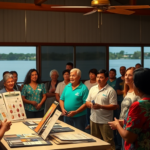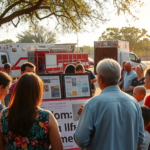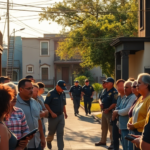### Tragic Incident in Brownsville Highlights Risks of Overheating in Vehicles
In a heart-wrenching incident that has sent shockwaves across the Rio Grande Valley, Brownsville police confirmed the tragic death of a four-year-old child found unresponsive in a daycare van. The child was discovered on Friday at The Learning Club Pre School on Paredes Line Road. Emergency services pronounced the young child dead at the scene, and investigations into the incident are currently underway.
This devastating event underscores the severe dangers posed by high temperatures inside locked vehicles, a serious concern for Valley residents as summer temperatures spike. This incident, coupled with a similar tragedy involving a three-month-old in rural Mission earlier this month, is a stark reminder of the fatal consequences of vehicular heat exposure.
### Rising Concerns over Vehicle Heat-Related Incidents
As we experience the sweltering days characteristic of South Texas, the internal temperature of vehicles can climb rapidly, reaching threatening levels in mere minutes. Safety experts emphasize that the consequences can be dire, particularly for children and pets left unattended.
“Even on a relatively mild day, the temperature inside a vehicle can become life-threateningly hot in just a few minutes,” remarked Dr. Michael Sandoval, a safety expert based in McAllen. “Parents and caregivers must remain vigilant. Always double-check the backseat and ensure all occupants have exited the vehicle.”
These incidents highlight an urgent community interest, pressing families to prioritize safety as part of daily routines. The troubling rise in such tragic events calls for heightened community awareness and preventive measures to protect the most vulnerable members of society.
### Community Impact and Response
The tragedy in Brownsville is a profound loss that reverberates through the close-knit communities of the Rio Grande Valley. It serves as a reminder of the ever-present risks associated with our region’s climate, demanding a collective response to prevent further tragedies.
Local authorities, civic organizations, and schools are being called upon to intensify educational campaigns about the dangers of vehicular heatstroke. Public service announcements might provide lifesaving tips, such as never leaving children unsupervised in a car and creating reminders to check the backseat.
“Holding workshops and distributing flyers at community centers and schools can significantly raise awareness,” suggested Lizette Garcia, a community advocate and mother of two. “We need to come together to ensure that our community remains informed and proactive in preventing these avoidable deaths.”
In addition to educational endeavors, local advocates are pushing for legislative changes that could mandate safety features in vehicles, such as automatic car seat alerts designed to remind caregivers of activity in the backseat.
### Connection to Broader Issues in South Texas
The death of the four-year-old in Brownsville, coming shortly after another tragic loss in Mission, is part of a broader pattern. These events reflect ongoing issues within South Texas, where extreme summer heat poses hazards beyond vehicular safety, affecting outdoor workers, the elderly, and vulnerable populations.
Meanwhile, in nearby communities, authorities are busy addressing unrelated concerns. In Starr County, law enforcement has apprehended undocumented immigrants, illustrating a complex tapestry of challenges faced by the region ranging from immigration to public safety. Additionally, Cameron County has been in the spotlight for arrests related to human smuggling, adding layers of urgency to resource allocation and political discourse.
### Future Implications and Looking Ahead
Moving forward, it is crucial for local leaders and policymakers to recognize the interconnected nature of these issues and work collaboratively to bolster community resilience. By integrating safety initiatives with existing programs on public health and education, the RGV can mitigate risks associated with the environment and enhance overall community welfare.
Initiatives such as improved infrastructure, community-driven safety protocols, and technology-driven solutions could play a pivotal role in addressing these challenges holistically. Additionally, engaging local colleges and universities to conduct research on effective preventive measures can be instrumental in shaping future strategies.
For immediate assistance and resources regarding child safety in vehicles, families in the Valley are encouraged to reach out to local health departments, visit online resources such as the National Highway Traffic Safety Administration (NHTSA) website, or contact their local authorities for guidance.
The Rio Grande Valley community’s resilience is its strength. Through awareness, education, and collective action, tragedies like these can be averted, paving the way for a safer, more informed RGV. The loss of young lives must become a rallying point for all Valley residents to ensure that such tragedies are prevented in the future.







